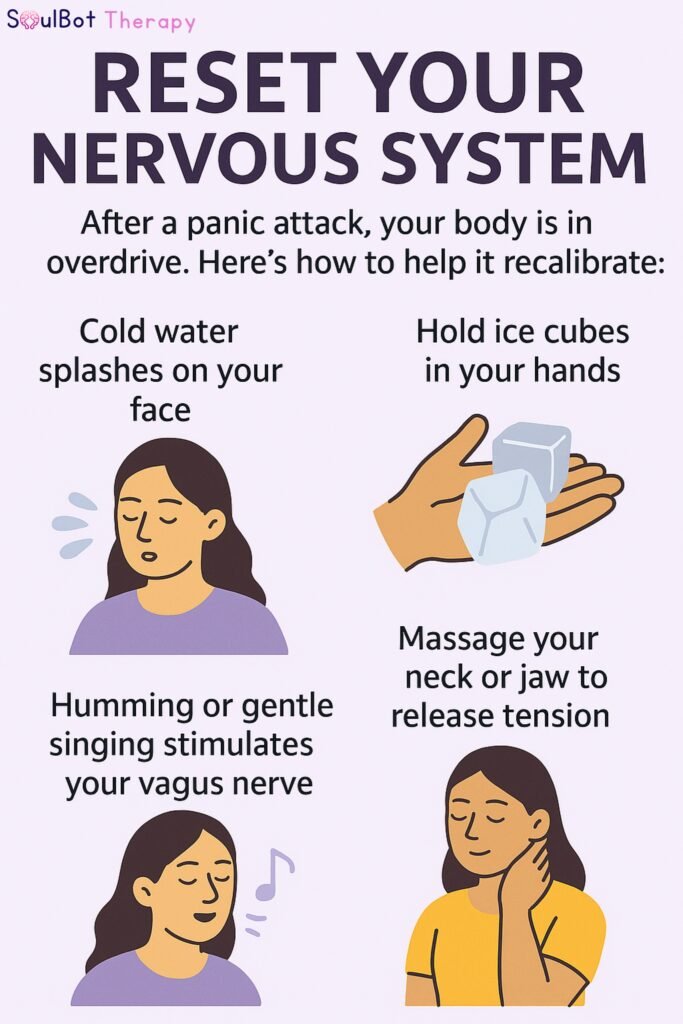What to do after a panic attack isn’t just a question; it’s a moment of survival.
Your heart races, your breath shortens, and reality slips out of focus. It’s terrifying, your chest tightens, thoughts spiral, and everything feels out of control. But here’s the truth: you’re not dying. You’ve just experienced a panic attack, and what you do next can shape your recovery. This isn’t about sugar-coated advice or confusing clinical terms. It’s a raw, honest guide to help you come back to your body, your breath, and your sense of self.
First: Ride the Wave
Right after a panic, your nervous system is still in overdrive. You’re not “back to normal” yet, and that’s okay. It’s not a weakness. It’s your body recalibrating.
Don’t just think about what to do after a panic attack, try this instead:
- Sit or lie down in a safe, quiet space.
- Acknowledge: “That was a panic attack. It’s over. I’m safe now.”
- Sip cold water. Slowly. Not to distract but to soothe.
What to Do After a Panic Attack to Reclaim the Mind?
This isn’t about “snapping out of it.” It’s about resetting.
- Use Grounding Exercises for Anxiety:
The goal isn’t relaxation. It’s anchoring. Try the 5-4-3-2-1 Method:
- 5 things you can see
- 4 you can touch
- You can hear
- 2 you can smell
- You can taste
It tells your brain: “We’re in the present. No threat here.” Grounding exercises for anxiety like this can be lifesavers in post-panic attack recovery.
2. Try Calming Techniques for Panic Attacks
- Slow breathing isn’t cliché, it’s science.
- Inhale for four counts
- Hold for 4
- Exhale for 6
Do this for a few rounds. You’re not just calming breath. You’re calming your vagus nerve, which helps regulate fear. Calming techniques for panic attacks are essential mental health coping skills for immediate relief.
🧠SoulFact: Excessive screen time, especially through doomscrolling, can heighten anxiety and panic by keeping you sedentary and overstimulated, amplifying stress responses in the brain. Limit your exposure to reclaim mental calm your mind deserves a break from the digital chaos.

Next Step: Mental Health Coping Skills That Stick
These attacks might feel like they hit out of nowhere, but they often stem from stress building quietly over time, emotionally, physically, or both. That’s where mental health coping skills come in.
- Journal what happened. What triggered it?
- Name the feeling: Was it fear? Helplessness?
- Talk to someone, a friend, a therapist, or even a bot.
- Try SoulBot for quick, private emotional check-ins anytime.
💬 Not sure how you usually cope or connect with others when you’re overwhelmed?
Take our Love Language Test to find your emotional support style. It really helps.
Emotional Regulation Tools for Aftercare
Don’t rush to “move on.” Emotional regulation tools are about pacing the comeback. Here’s how:
- Take a warm shower or bath (yes, sensory reset again)
- Eat something nourishing (avoid sugar/caffeine)
- Gentle stretching or walking lets your body move through it
These emotional regulation tools support how to reset your nervous system naturally.
Post-Panic Attack Recovery Isn’t Linear
You might feel “off” for hours or even a couple of days. That’s not failure. It’s the post-panic attack recovery curve.
What helps:
- Sleep (if you can, nap. If not, rest.)
- Limiting screen time doomscrolling raises cortisol
- Repeat gentle routines (like tea, music, art)
- Avoid big decisions in the next 24 hrs
You’re not weak. You’re healing. Remember, what to do after a panic attack includes prioritizing this phase of post-panic attack recovery; you must also know what a panic attack feels like.
“That awkward moment when your heart races faster sitting still than it does during a workout. Thanks, anxiety.”
How to Reset Your Nervous System?
Here’s the deal: your nervous system isn’t just mental, it’s physical.
Try these body-first resets:
- Cold splash on face or wrists
- Tapping technique (EFT) on the collarbone or temples
- Humming or singing stimulates the vagus nerve
- Weighted blanket if you have one
These aren’t “tricks,” they’re proven emotional regulation tools. Learning how to reset your nervous system is key to what to do after a panic attack.
What Not to Do After a Panic Attack
- 🚫 Don’t ignore it
- 🚫 Don’t numb it with substances
- 🚫 Don’t isolate completely
- 🚫 Don’t shame yourself for “breaking down”
What this really means is: your body asked for help in the only language it could. You listened. That’s power. Instead of spiraling, shift your focus to what to do after a panic attack: try calming techniques for panic attacks, grounding exercises for anxiety, and small steps that bring your body and mind back into balance.
“You are not a mess. You’re a deeply feeling person in a messy world.”
– Glennon Doyle.
Final Word
You survived the storm. Now it’s time to rebuild the calm.
The next time a panic attack strikes, you’ll know what to do after a panic attack because you’re not powerless. You’re informed, prepared, and grounded with mental health coping skills and emotional regulation tools. And that changes everything.








